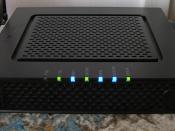Two internet technologies have emerged over the past several years for switched data communications services. Cable Modems operate over two-way hybrid fiber/coax and provide user rates as high as 10 Mbps. The average speed most user will see is at around 550-650 KB or (4500-5500 Mbps), but some people may experience slightly faster speeds. ADSL Modems (Asymmetric Digital Subscriber Lines) operate over existing copper telephone lines and provide rates as high as 8 Mbps, but more realistic speeds for a DSL user are approximately 175 KB or (1.5 Mbps). Both technologies address the large markets for Internet access, remote LAN access for work at home and telecommuting, and network access for the hundreds of millions of personal computers in place today and to be sold over the next ten years. The speeds also depend on your ISP, for example Cablevision offers up to 10 Mbps downloading, where Time Warner's road runner cable service is only at 2 Mbps, therefore the speed will also vary from providers.
Cable modems may offer more raw speed than ADSL, but that advantage is compromised by inevitable reductions in available cable modem speed. Cable modems share a line with tens of thousands of other users; as more users join a line, the capacity available to any one inevitably drops. Therefore, the control of speed is all up to your cable company, depending on how many people they place on a node, will determine how much loss of speed you have. The top speeds of both technologies will not be usable for years anyway. Internet server speeds, network delays, and personal computer limitations will hold usable rates at approximately 4500 - 5500Mbps for some time. Both technologies are at about the same state of maturity and integration. Cable modems may offer a less expensive network...


